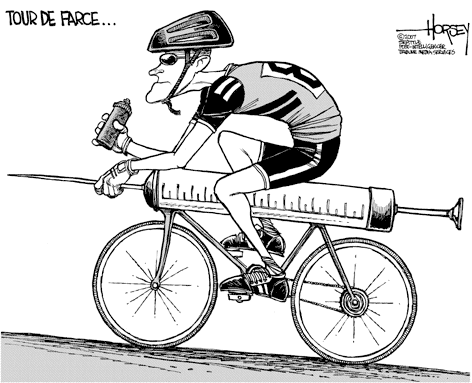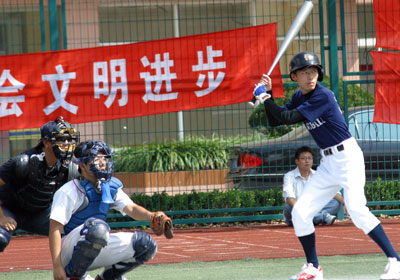Elise Edwards is Assistant Professor of Anthropology at Butler University in Indiana. Her research interests include issues of gender, sexuality, and national identity in Japan, particularly as they are articulated and disciplined through technologies of sports, recreation, and physical education. She is currently working on a book about soccer, corporate sport, and national identity construction in Japan in the late 1990s and into the present, which is tentatively titled Fields for the Future: Soccer, Nation, and Citizens in Japan at the Turn of the 21st Century. Elise played for three seasons in Japan’s women’s professional L-League in the mid-1990s, and continues to be involved with the sport, serving as the goalkeeping coach for Butler University’s varsity women’s team.
Fuji. One of the reasons I study sports is that in both China and the United States, I’ve found that everyone has something to say about sports – not always positive, which makes it more interesting – and it’s a good way to get a conversation going. Plus, as a teacher, it’s a good way to grab students’ interest and get them to think more critically about their own culture. What motivated you to study sports?
Elise: You’re right, almost everyone has something to say about sports, even if it’s simply that they “hate them,” which is a response that can actually lead to some very productive conversations if that person is willing to expand upon what it is that they hate about sports.
My own interest in studying sports stemmed first and foremost from my own experiences as an athlete. I played a variety of different sports – volleyball, basketball, softball, and soccer – throughout most of my childhood and on into high school. I ended up playing soccer in college for Division I program. In many ways, sports was what I knew best, but not really in any kind of critical, or analytical sense…although now that I think about it, from early on, but only at a rather basic level, I was aware that sport played an important role in structuring gender relations, and that it was both reflective and reaffirming of normative ideas about sexuality. I think that most girls who are labeled “tom boys” – or, boys who are called “sissies” because they skate – are well aware of some of the powerful ways that sports impose meanings on bodies and help maintain a particular gendered order. Personally, I think I felt both frustrated and empowered by various cultural meanings attached to sport, and that long before I began my graduate research I was curious about why and how sport worked the way it did. In addition, I think that some of my early childhood questions about why only boys were supposed to play certain sports, or girls were supposed to be “naturally” better at others fueled my early interest; and, the fact that many people continue to think that way inspires me to continue to teach about the history and anthropology of sport, and to do my research.
I guess I got derailed a little bit with my answer above. Despite my general interests in sports, I did not plan on working on sport issues, and definitely didn’t imagine doing fieldwork on women’s soccer in Japan, before I entered into graduate school. After I finished my undergraduate degree, I actually played soccer for the professional women’s league in Japan that is one of the main focuses of my current work. I spent three seasons with a team in the Tokyo area that was sponsored by what was one of the largest securities firms in the world at that time. The experience was amazing and definitely cemented my conviction that I wanted to go to graduate school to learn more Japanese and a lot more about Japanese history and culture. When I returned to the states to begin my graduate work, my advisor strongly encouraged me to do fieldwork on the league. I’m embarrassed to admit that the idea had never crossed my mind before that point – what can I say, I was young and naive – but I knew it was an excellent one as soon as she said it.
As soon as I began seriously studying sport, my interests rapidly broadened and deepened. I was fascinated, for instance by the ways that physical education and sports were used in the late19th and early twentieth centuries by the newly formed Japanese Meiji state to train new dispositions and forms of discipline that would serve the needs of the rapidly modernizing and industrializing country. Or, the fact that up until the final days of WWII, sports and physical fitness initiatives were central parts of government programs aimed at cultivating male bodies to become strong and regimented soldiers, and female bodies to become strong reproductive vessels that could produce plenty more soldiers for future years. I am fascinated by the ways that the women’s volleyball team that won gold in the 1964 Tokyo Olympics, as well as other teams, were drawn into broader cultural discourses ranging from how to reconcile the pain and suffering endured over more than a decade of wartime hardship, to how to explain the double digit GNP growth and new affluence the country was experiencing in the 1960s and ‘70s. And, arguably, I’m most fascinated (since this is the focus of my own research) by the cultural role of soccer in Japan in the 1990s as a medium through which various commentators – including plenty of sports journalists, coaches, and players – waged debates about the kinds of citizens needed to help Japan overcome its serious recession and make Japan competitive in the “new global market.” It should be added, that many of those same people also saw soccer as the ideal means of training those new “global citizens.”
Fuji:. But Japan already seems so global, what with all the technology, exporting of Japanese culture through Pokemon and anime, and exporting of Japanese people as tourists and businesspeople. Is there something about soccer that makes it seem like a more appropriate medium to making Japanese feel global?
Elise: Well, of course, Japan already is global, and in fact, has been global for quite a long time, in the sense that it has interacted and traded with regions and nations around the world for centuries. I think contemporary commentators’ assertions of the “newness” of current globalization stem from two facts: 1) the common but inaccurate belief held by many in Japan that until recently (literally the last couple decades) the country has been incredibly insular and ethnically homogeneous; and 2) despite the fact that Japan was part of global networks and flows for many centuries, in just the past couple decades the nature of those interactions has changed quite dramatically due to the communicative power of the internet, the liberalization of international financial markets, and so on.
Of course, ultimately, whether Japan – or, the world – is more global is a question worthy of debate, but for my purposes the most important thing is that policymakers, journalists, coaches, and others have felt like it is, and that they point to soccer as both resulting from, and being emblematic of this new global system. Many have drawn comparisons between baseball and soccer, with baseball and its militaristic-style training symbolizing the hardworking, group-oriented, and hyper-disciplined Japan of the past, and soccer representing the rapidly changing, foreign derived, and more individualistic post-industrial economy and culture of the present. In this overdrawn binary, baseball is marked as the “national” or “domestic” sport, in contrast to the “international” game of soccer. This is rather ironic since the two sports were actually both introduced to Japan in the early 1870s. (Of course, baseball, as some of these commentators have pointed out, has no equivalent to soccer’s World Cup Tournament, making it less of a “global sport.”) Other writers have suggested that the skills required of soccer players on the field – as individual decision makers in a complicated web, or network, of 21 other players – are exactly the skills required of workers in the new 21st century economy. Of course, for many soccer represents things other than globalization and its requisite dispositions; players, fans, and plenty of sports writers have characterized soccer as embodying a new found individuality and a spirit of change in the country. In 1993, the year the J-League launched, I remember a forty-year old female friend gesticulating wildly as she explained how these young soccer players expressed the freedom and rebelliousness of youth culture in a way not found in baseball. In her opinion, it was wonderful – to watch and for Japan.
Fuji: Back to your point about gender. One of the common complaints against Title IX is that equal opportunity can never really be attained because men are more interested in sports than women, and there will always be more men than women wanting to play varsity sports. Do you think that’s really true?
Elise: I’m always annoyed when I hear this kind of argument against the legislation. To suggest that men are simply more interested in sports is to mistakenly suggest that this is somehow a natural quality of the male sex and deny the cultural forces behind that interest. I think this is the kind of the question that is easiest for me to comment on from a personal perspective as a player and a coach. I’ve worked with female and male athletes for years, and I’ve never seen anything that’s made me believe that either sex inherently likes sports more than the other. Why they play sports and what they get out of them do at times appear to be different, but this I’m quite sure can be attributed to the power of culture.


